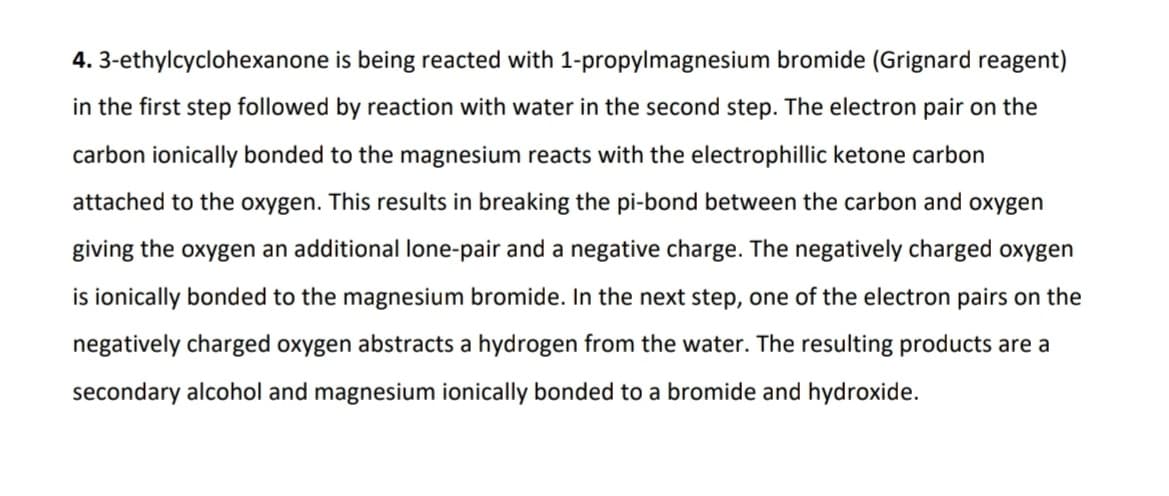4. 3-ethylcyclohexanone is being reacted with 1-propylmagnesium bromide (Grignard reagent) in the first step followed by reaction with water in the second step. The electron pair on the carbon ionically bonded to the magnesium reacts with the electrophillic ketone carbon attached to the oxygen. This results in breaking the pi-bond between the carbon and oxygen giving the oxygen an additional lone-pair and a negative charge. The negatively charged oxygen is ionically bonded to the magnesium bromide. In the next step, one of the electron pairs on the negatively charged oxygen abstracts a hydrogen from the water. The resulting products are a secondary alcohol and magnesium ionically bonded to a bromide and hydroxide.
4. 3-ethylcyclohexanone is being reacted with 1-propylmagnesium bromide (Grignard reagent) in the first step followed by reaction with water in the second step. The electron pair on the carbon ionically bonded to the magnesium reacts with the electrophillic ketone carbon attached to the oxygen. This results in breaking the pi-bond between the carbon and oxygen giving the oxygen an additional lone-pair and a negative charge. The negatively charged oxygen is ionically bonded to the magnesium bromide. In the next step, one of the electron pairs on the negatively charged oxygen abstracts a hydrogen from the water. The resulting products are a secondary alcohol and magnesium ionically bonded to a bromide and hydroxide.
Chemistry
10th Edition
ISBN:9781305957404
Author:Steven S. Zumdahl, Susan A. Zumdahl, Donald J. DeCoste
Publisher:Steven S. Zumdahl, Susan A. Zumdahl, Donald J. DeCoste
Chapter1: Chemical Foundations
Section: Chapter Questions
Problem 1RQ: Define and explain the differences between the following terms. a. law and theory b. theory and...
Related questions
Question
Draw the reaction

Transcribed Image Text:4. 3-ethylcyclohexanone is being reacted with 1-propylmagnesium bromide (Grignard reagent)
in the first step followed by reaction with water in the second step. The electron pair on the
carbon ionically bonded to the magnesium reacts with the electrophillic ketone carbon
attached to the oxygen. This results in breaking the pi-bond between the carbon and oxygen
giving the oxygen an additional lone-pair and a negative charge. The negatively charged oxygen
is ionically bonded to the magnesium bromide. In the next step, one of the electron pairs on the
negatively charged oxygen abstracts a hydrogen from the water. The resulting products are a
secondary alcohol and magnesium ionically bonded to a bromide and hydroxide.
Expert Solution
This question has been solved!
Explore an expertly crafted, step-by-step solution for a thorough understanding of key concepts.
This is a popular solution!
Trending now
This is a popular solution!
Step by step
Solved in 2 steps with 1 images

Knowledge Booster
Learn more about
Need a deep-dive on the concept behind this application? Look no further. Learn more about this topic, chemistry and related others by exploring similar questions and additional content below.Recommended textbooks for you

Chemistry
Chemistry
ISBN:
9781305957404
Author:
Steven S. Zumdahl, Susan A. Zumdahl, Donald J. DeCoste
Publisher:
Cengage Learning

Chemistry
Chemistry
ISBN:
9781259911156
Author:
Raymond Chang Dr., Jason Overby Professor
Publisher:
McGraw-Hill Education

Principles of Instrumental Analysis
Chemistry
ISBN:
9781305577213
Author:
Douglas A. Skoog, F. James Holler, Stanley R. Crouch
Publisher:
Cengage Learning

Chemistry
Chemistry
ISBN:
9781305957404
Author:
Steven S. Zumdahl, Susan A. Zumdahl, Donald J. DeCoste
Publisher:
Cengage Learning

Chemistry
Chemistry
ISBN:
9781259911156
Author:
Raymond Chang Dr., Jason Overby Professor
Publisher:
McGraw-Hill Education

Principles of Instrumental Analysis
Chemistry
ISBN:
9781305577213
Author:
Douglas A. Skoog, F. James Holler, Stanley R. Crouch
Publisher:
Cengage Learning

Organic Chemistry
Chemistry
ISBN:
9780078021558
Author:
Janice Gorzynski Smith Dr.
Publisher:
McGraw-Hill Education

Chemistry: Principles and Reactions
Chemistry
ISBN:
9781305079373
Author:
William L. Masterton, Cecile N. Hurley
Publisher:
Cengage Learning

Elementary Principles of Chemical Processes, Bind…
Chemistry
ISBN:
9781118431221
Author:
Richard M. Felder, Ronald W. Rousseau, Lisa G. Bullard
Publisher:
WILEY